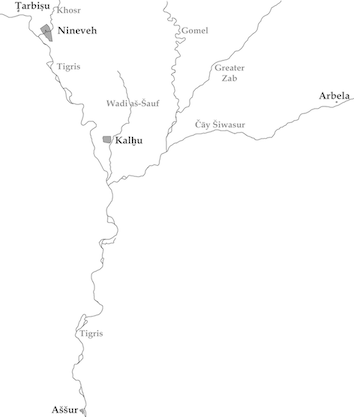Building Activities in Assyria

Figure 5. Map showing some of the Assyrian cities where Ashurbanipal undertook building activities.
Numerous texts describe Ashurbanipal's many building activities in Assyria. In the prologues of some of his annalistic texts inscribed on multi-faceted clay prisms (edited in Part 1), the king provides a vague overview of his (temple) building activities, stating:
From the textual and archaeological records, it is known that Ashurbanipal sponsored building programs in at least seven Assyrian cities: Arbela, Aššur, Ḫarrān, Kalḫu, Milqiʾa, Nineveh, and Tarbiṣu. Full details about Ashurbanipal's building activities in Babylonia, as well as those carried out by Aššur-etel-ilāni and Sîn-šarra-iškun, will be given in the introduction of Part 3.[35] For general studies, see in particular Frame, RIMB 2 pp. 194–195 and 261; Grayson, CAH2 3/2 pp. 155–158; Novotny, Eḫulḫul; Novotny, Studia Chaburensia 8 pp. 73–94; and Novotny and Van Buylaere, Studies Oded pp. 215–219. These building projects will be discussed by city, geographically within the Assyrian Empire, starting with the administrative capital Nineveh.
Notes
[34] Translation conflated from Novotny and Jeffers, RINAP 5/1 p. 58 no. 3 (Prism B) i 16–23 and p. 83 no. 4 (Prism D) i 14–19a.
[35] Information about Ashurbanipal's building projects, despite statements made in Part 1, will be split over two volumes. The Assyrian building projects will be discussed here, while his Babylonian building activities will be studied in Part 3, principally since his Babylonian inscriptions will be edited in that volume.
Jamie Novotny
Jamie Novotny, 'Building Activities in Assyria', RINAP 5: The Royal Inscriptions of Ashurbanipal, Aššur-etel-ilāni, and Sîn-šarra-iškun, The RINAP/RINAP 5 Project, a sub-project of MOCCI, 2022 [http://oracc.org/rinap/rinap5/RINAP52Introduction/BuildingActivitiesinAssyria/]